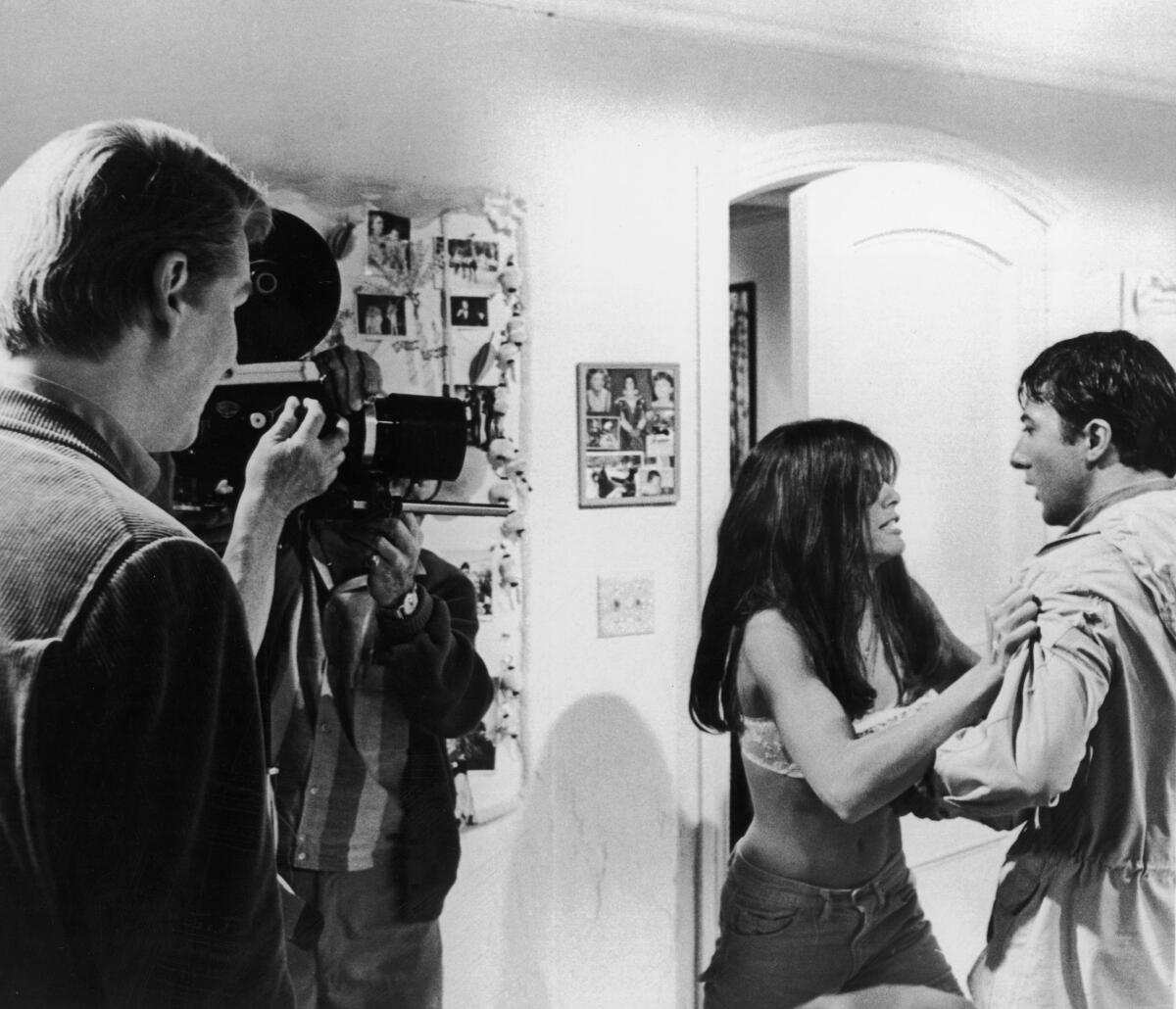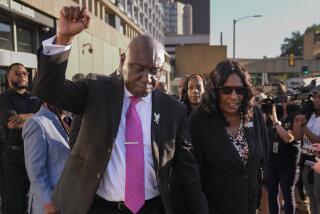Review: In ‘Mike Nichols: A Life,’ a brilliant portrait of the director who made his luck
On the Shelf
Mike Nichols: A Life
By Mark Harris
Penguin: 688 pages, $35
If you buy books linked on our site, The Times may earn a commission from Bookshop.org, whose fees support independent bookstores.
Mike Nichols was a relatively novice filmmaker when he shot “The Graduate,” and the first time he saw it with a paying audience, he wondered if he’d made a dud. Nichols and its star, Dustin Hoffman, were sitting together in the balcony, unsure how it was playing, when the answer rose up like thunder from below: The audience was on its feet, cheering. “We were speechless,” Nichols said. “We didn’t understand why people were going nuts…It never crossed our minds that it would have such a shocking reaction.” “The Graduate” ended its initial run as the third highest grossing movie of all time, behind only “Gone With the Wind” and “To Kill a Mockingbird.”
“The film became not only an instant hit,” Mark Harris writes in his new biography, “Mike Nichols: A Life,” “but a cultural milestone that was widely seen as Hollywood’s first great exploration of the generation gap.” As Harris says, this was a subject in which Nichols “had little interest.” He was interested in a shrewdly observed sex farce about an older woman seducing a hapless young man. But college enrollment had exploded in the ‘60s; there was now a mass audience eager to see itself in Benjamin, the “graduate” who steals his life back from the machinating hypocrites. And so the schlemiel became a stand-in for a generation.
You’ll spend much of Harris’s judicious and superbly well-written book trying to puzzle out the relationship of Nichols’ talent to his good fortune. With “The Graduate,” he’d stumbled upon the ticket-buying prowess of the young. But was it luck that he cast Dustin Hoffman? In the original novel, Benjamin was a tall, athletic WASP. Hoffman — then 30, a gifted nobody toiling away off-Broadway — was considered too old, too short, too Jewish for the part. So what? Hoffman, as Nichols knew, had “that secret,” as he said, the ability to just be on screen.
As they filmed, Hoffman became something of a stand-in for Nichols, a notably tall man with a high WASP aura who was secretly part schlemiel himself: the consummate insider who was really an outsider, a neither/nor man leading a neither/nor life. Nichols was born Michael Igor Peschkowsky in Berlin, then was summarily hustled off to the United States at the age of 7 to escape the Nazis. After a spell with a foster family, he reunited in New York City with his parents — a mixed blessing, as they fought bitterly. “Aren’t all childhoods bad?” he once said, neither answering nor deflecting the question.

When he was 13, his father, a doctor, died suddenly of leukemia. With a neurasthenic mother now in charge, the Nichols family hobbled forward, neither well-to-do nor destitute. Young Mike fell hard for the movies, though not as a cinephile. Bullied at school — he’d lost all his hair at the age of 4 thanks to the whooping cough — he loved the “balconies and recesses where a kid could make himself scarce,” Harris writes. Over time, he refined a set of childhood defenses into a kind of special power: “You must learn to hear people thinking.”
Mike Nichols, Oscar-winning director of “The Graduate,” died at 83 of cardiac arrest at his home in New York.
Eavesdropping on the mental lives of others — this is not a skill that expresses itself best in formal academic settings. Graduating high school, Nichols had no idea what to do with himself — he’d been at best a directionless student — but on a lark, he took the grueling admissions test for the University of Chicago. To his surprise, he passed. And then: that magic baptism, the cleansing away of your former self when you first enter into the company of other super-bright weirdos! Before he’d matriculated — he was in line to register — he met an exceptional misfit named Susan Sontag. Soon after he met another in Paul Sills, who would later found the legendary Second City improv troupe; and through Sills, he met Elaine May.
To know Elaine May is (apparently) a special kind of ecstasy, laced with a special kind of pain. Here was another neither/nor type: neither the most brilliant woman in Nichols’ life (that was Sontag) nor the most beautiful (that was, soon enough, Elizabeth Taylor), but as everyone quoted herein attests, nobody smarter was prettier, and nobody prettier was smarter.
After trying sex (um, no), Nichols and May went public as a comedy duo. They were terrible — Nichols especially — until one night they made a remarkable discovery. Between withering contempt and lowbrow sentiment lay another possibility, a style of comedy marrying ice-cold precision with a degree of affection. In the middle of a sketch, they got it. As importantly, the audience got it with them.
From that moment on, the sheer physics of Mike Nichols’ life — its scope, velocity and magnitude — is hard to comprehend. Nichols and May blew up, became a Thing, helping create what now goes by the name “upper middlebrow” taste. Their humor posed itself against Ike and the suburbs but without so much as a foretaste of countercultural spite. They buoyed along gently on the unpretentious know-it-all-ism of referential humor. (If they said “Pirandello,” you knew to laugh knowingly.) They appeared frequently on TV, sold comedy LPs by the ton. By 1958, Nichols — who’d been living on ketchup squirted into hot water — was rich and famous.
THE more things change, the more they stay the same.
Nichols and May arrived on Broadway just as John F. Kennedy entered the White House. The conformist ‘50s, their bread and butter, were ending; but even this was a stroke of luck. As Harris details brilliantly, this was the moment high society gave way to café society, when a new power stratum supplanted the old WASP guard. The new American elite, blending high-toned meritocracy and gangsterish swagger, was a milieu in which Nichols thrived. Though he had never given much thought to directing, he’d been obsessed with Method acting since being “poleaxed” (his word) by Marlon Brando onstage in “A Streetcar Named Desire.” “It was the only thing I’ve ever seen,” he once said, “that was a 100% real and a 100% poetic, simultaneously.”
To make things at once real and poetic — Nichols had his remit, but it took one more stroke of extraordinary luck to make him a director. After Nichols and May ran its course, he thought maybe he’d try being an actor. After that went nowhere, he was given his first real directing job, at the Bucks County Playhouse in Pennsylvania. The playwright was an ex-TV gag writer, the leading man a laconic, too-handsome-by-half golden retriever type who wasn’t sure he wanted to be an actor. Under Nichols’ tutelage, Neil Simon’s play, starring Robert Redford, became “Barefoot in the Park.”
He had four hits in his first 18 months as a Broadway director, an astonishing streak that won him the job directing the film adaptation of “Who’s Afraid of Virginia Woolf?” He had no background in moviemaking, no facility with its technical aspects. Elizabeth Taylor was thought to be badly out of her depth; Richard Burton was an ocean-inhaling alcoholic. As paramours, they existed at the center of a “worldwide soap opera,” Harris writes. The material, meanwhile, was grim — a marriage descending into sadism and claustrophobia. To satisfy Hollywood, the play’s obscenities had to be cut, and to keep the pacing right, some of its best jokes would go, too. The degree of difficulty could not have been higher. Nichols delivered a masterpiece.
His second film, “The Graduate,” assured his place in both movie history and the In Crowd. And yet, after some other gigantic success, he asked his girlfriend, Gloria Steinem: “Why don’t I feel anything?” Why indeed? “Mike Nichols: A Life” is more the story of a career than a life, of a man who so feared downtime he cluttered it with showplace apartments, country squire estates, Arabian horses and, predictably, trophy spouses. And the critical bead on him got drawn early: He “imparts muscle to what he touches but not soul,” said one of his first critics, and as many have noted since, his movies are defined by precision and urbanity but also a certain chilly self-regard.
Fifty years ago last month, a lacerating, dark comedy-drama opened in theaters, helping change the landscape of American cinema.
Yet the pattern is unmistakable: Out of a lack of a fixed and knowable self came a majestic enabler of others. He labored hard on the scripts he directed, while rarely usurping the writer; with a company, he knew when to hang back, to create the vacuum into which its collective soul might emerge. And for actors, Nichols had an almost reverential awe.
His peculiar gift was for making them feel safe being precarious. The essence of life is that it unfolds chronologically and according to no script. Actors must capture this essence, then somehow transfer it into highly artificial situations. If Nichols played taskmaster, it was only to remind them that what is happening here has never happened before; you have no idea what others will say or do next, you must stay spontaneous and reactive — all while subordinating yourself to a larger story. That was, finally, the great, impossible neither/nor of his genius, as it is, too, of Mark Harris’ wonderful book.
Metcalf is cohost of Slate’s “Culture Gabfest” podcast and is writing a book about the 1980s.
More to Read
Sign up for our Book Club newsletter
Get the latest news, events and more from the Los Angeles Times Book Club, and help us get L.A. reading and talking.
You may occasionally receive promotional content from the Los Angeles Times.







